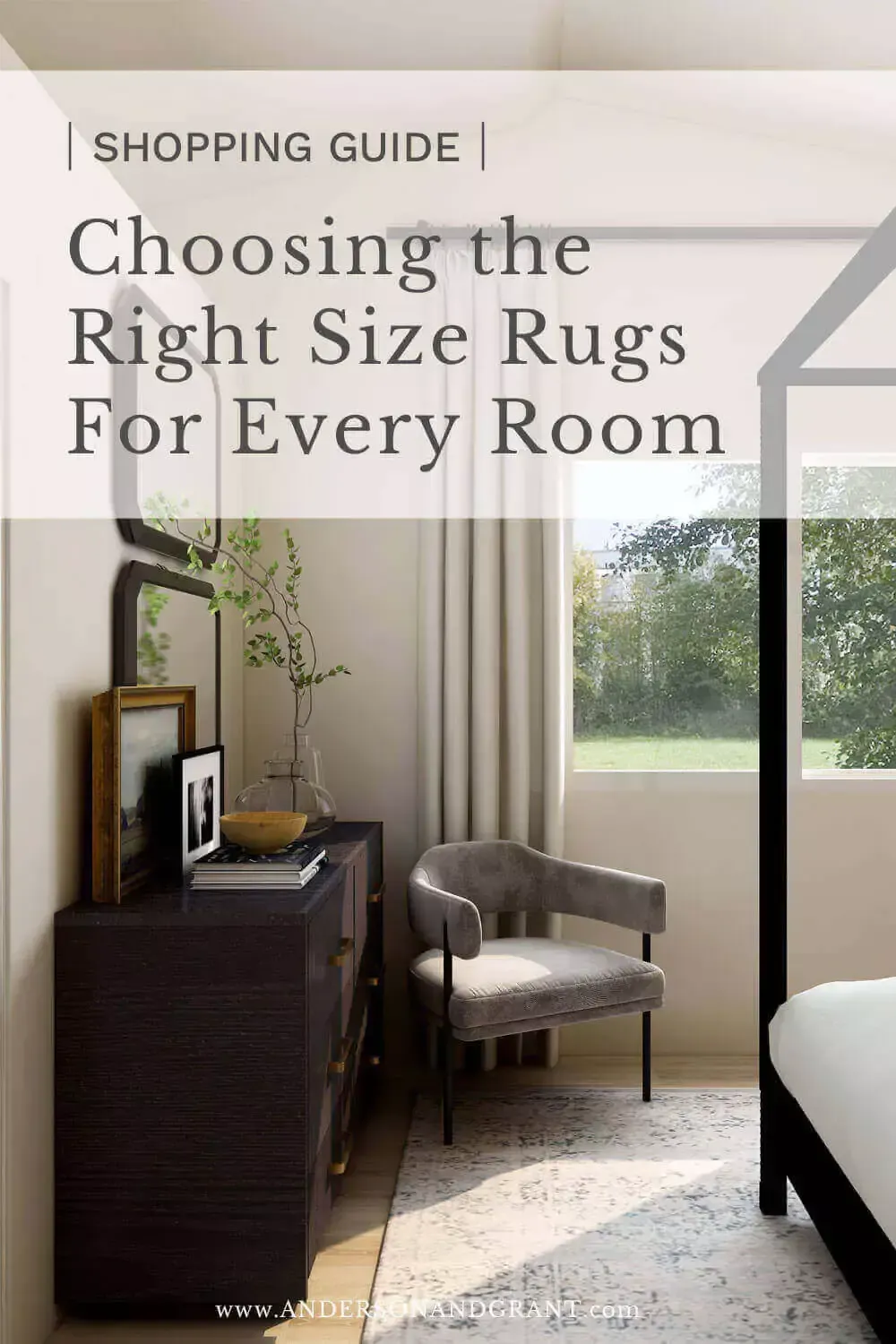Your complete rug size guide featuring everything you need to know about choosing the right size area rugs for your home, including measuring tips and specifics about layouts and sizing for every room in your home.
DESIGN + STYLE | Updated March 24, 2023

Area rugs add pattern, texture, color, and personality to any space, bringing your entire room design together.
Lay down the wrong size, though, and you’ll likely see the opposite effect you hoped for. No matter how beautiful the décor and layout, using a rug that is too small or too large will leave the entire space feeling off and unpolished.
Unfortunately, it is easy to misjudge the size of rug you need and choosing one that is too small is a common decorating mistake. Sizes are deceptive (6-foot by 9-foot sounds big until you get it into the living room!) and retailers tend to stock more of the smaller sizes as they’re cheaper and easier to display...leading you to believe they must be big enough. And quality rugs are expensive, especially the largest sizes, so the smaller options seem like a “better value.”
Buying an area rug doesn’t have to be a scary commitment or stressful decorating decision as long as you can keep a few tips in mind concerning the room you are decorating. This post will guide you through understanding what impacts the size of rug you need, how to measure for the right one, and the exact sizes and layouts to consider for every room of your home so that you can confidently pick the right size area rug for your home.
If you’d like some more visual references of the layouts being described in this post, click here to see over 100 examples featuring all different ways to arrange rugs throughout your home.

YOUR COMPLETE GUIDE TO CHOOSING THE RIGHT SIZE RUGS FOR YOUR HOME
Why Does Rug Size Matter?
Using a rug that is the wrong size can negatively alter the otherwise beautiful design and feel of your room.
- When the sizing is wrong, your attention will naturally go to the imbalance, rather than the overall look you’re trying to create.
- Laying down a rug that is either much too small or too large for the space and the amount of furniture you have will look awkward and make the overall room appear smaller than it is.
- In dining rooms and home offices where chairs are being moved around, size is important for safety considerations. It is easy for chair legs to catch on the edge of a too-small rug causing it to curl and become a tripping hazard.
- Switching out a 5’x8’ rug for an 8’x10’ rug can make it feel as though you’ve doubled the size of your living room.
A rug that is somewhat too big is generally fine. There just needs to be enough floor space showing as a border between the rug and wall to keep the rug from looking like wall-to-wall carpeting.
4 Things That Impact the Size of Rug You Need
No. 1: SIZE OF YOUR ROOM
In order to look like it belongs, the size of your rug needs to be proportional to the size of the space.
No. 2: SHAPE OF ROOM
The rug you choose should match the shape and orientation of your room. For most, this means choosing a rectangular rug. But if you have a square shaped room, a square or round rug may look best.
Also, the rug should follow the orientation of the room, meaning the longest side of your rug runs along the longest side of the room.
No. 3: SIZE AND LAYOUT OF THE FURNITURE IN THE ROOM
Rugs also need to be proportionate to the size of the furniture included in your room design. Certain layouts require rugs that are different in size to other layouts. (More about that later in the post.) Larger furniture like a sectional or dining table for twelve will call for a larger rug than more petite furnishings.
No. 4: YOUR DESIGN PREFERENCES
While “rules” are helpful when giving your home a makeover, you ultimately must design based on what you think looks and feels best. The guidelines that follow tell what will likely work, but you must also make decisions about what you want. Do you want all of your living room furniture on the rug or just the front legs? Do you want a room-sized rug under your bed or is the rug just an accent?
Rug Basics
- A rug that is too big is better than one that is too small. And if you are unsure of the right size for your space, opting for the large rug is a safer choice.
- Area rugs should never be touching a wall. You want to leave about 18” to 24” of exposed flooring around the perimeter of the room to frame the furniture layout and keep the rug from looking like “almost” wall-to-wall carpeting. In smaller spaces, 8” to 12” is likely adequate exposed space.
- You can lay rugs over hardwood flooring, tile, wall-to-wall carpeting or even other rugs, although avoid adding a high pile rug over a high pile carpet.
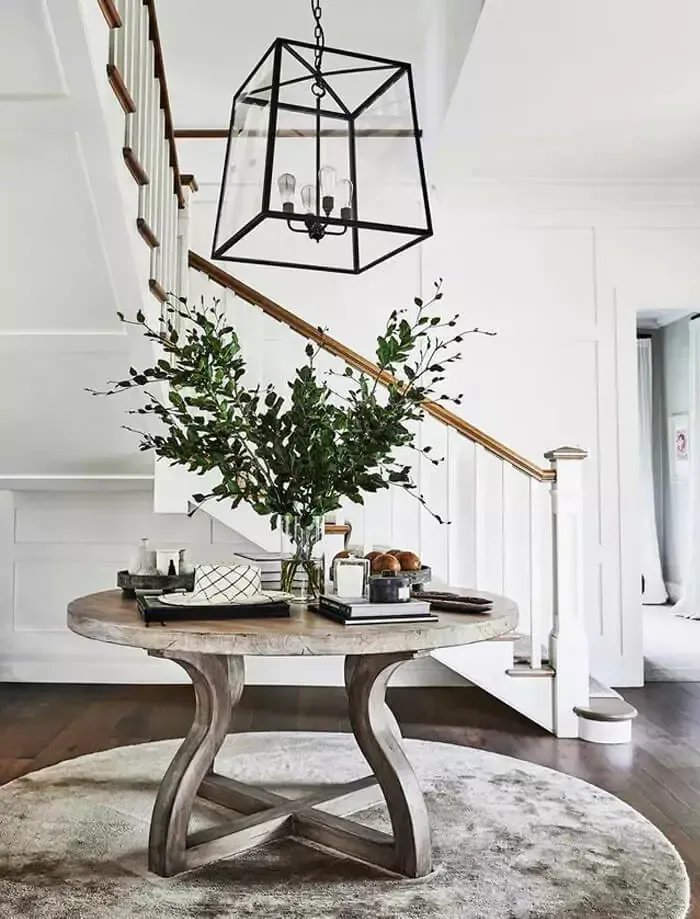
Tess Newman Morris @tess.newman.morris
There are not a lot of places where round (or octagonal) rugs work in the home, but under a round table in the foyer is a perfect option for bringing a little personality to the formal entry. Because you aren’t using the rug as anything other than a visual accent, just make sure to choose a size that is larger than the circumference of your table.
Standard Rug Sizes
Most rug designs come in a variety of standard sizes complementing the measurements of typical home construction. Manufacturers tend to offer their designs in at least three or four of these sizes.
But there are a lot of off-sizes, too, that may better work for the space constraints you have. It is best to know the exact “right” size you need and see what is available for you to work with.
These are the typical shapes and sizes available on the market:
- Rectangular Accent Rugs: 2’x3’, 3’x5’
- Rectangular Area Rugs: 4’x8’, 6’x9’, and 8’x10’
- Rectangular Room Size Rugs: 9’x12’, 10’x14’, 12’x15’
- Runners (long and narrow rugs): Usually between 2 ½ to 3’ wide and come in a range of different lengths from 8’ to 12’ long.
- Oval Rugs: Normally available in 9’ dimensions, although you can find some oval shaped accent rugs as well.
- Square Rugs: 4’x4’, 6’x6’, 8’x8’, 10’x10’
- Round Rugs: Between 4’ and 10’ across
- Octagonal Rugs: 4’, 6’, 8’
If you have an odd-shape or sized room, look for vintage rugs. Many older rugs come in non-standard sizes, including square which can be harder to find.
Layering Rugs
You may have a rug you love that’s too small for the space or a vintage rug that comes in an odd dimension, but that doesn’t mean that you can’t still use it. The secret is to layer the petite rug over a larger neutral rug.
This is also a solution if you want to save a little money on a pricey rug – buy the smaller size and layer it over a larger, less expensive option.
- Choose a natural jute, sisal, or neutral wool as the large base rug and then top it with a smaller rug in a different color and material. You want two rugs that contrast in color and texture.
- The layered rug should be about 2/3 the size of the larger rug. Make sure the difference is enough to show off each rug. For example, a 6’x9’ rug looks perfect over a 9’x12’ rug.
- Pay attention to where the rug on top falls in relation to your furniture. You don’t want it to look like the sofa leg is just falling off of the smaller rug and for stability issues, you don’t want to have the end table positioned on two different rug heights.
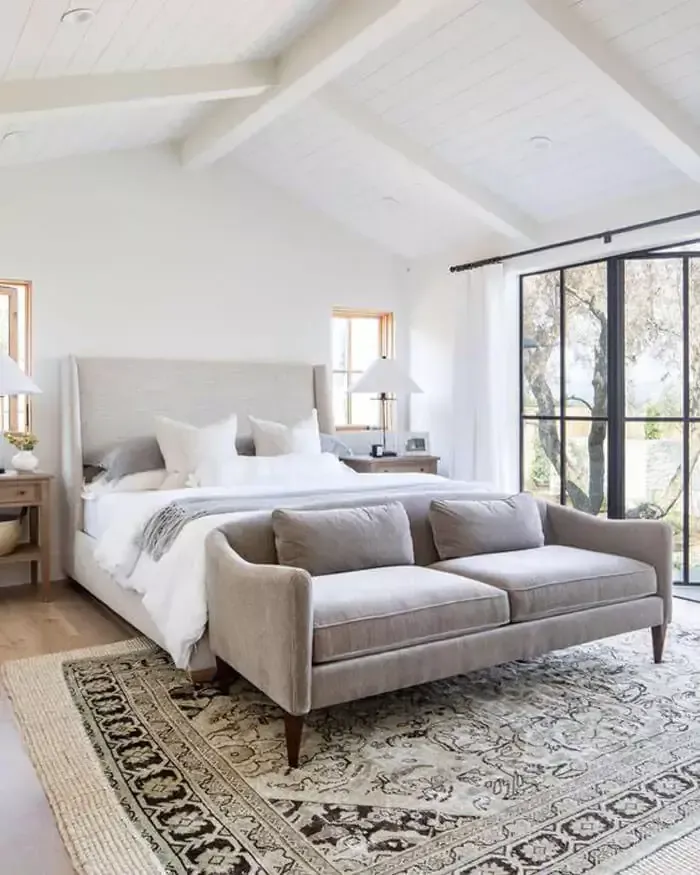
Studio McGee @studiomcgee
In this grand bedroom, Shea shows how to make a slightly too small vintage rug work under the bed by layering it over a larger natural textured rug. The additional rug allows the patterned piece to be moved to just under the foot of the bed creating space for a sofa and bringing the entire furniture grouping together in the design.
Measuring for Your Rug
Before you think about shopping for your perfect rug, you need to measure for the right size. It is important to be able to visualize its size and placement in your space.
- Position your furniture where it will go in the space (or get a good idea of where it will be and the space it will take up if something isn’t available). In the next section of this post, you’ll read suggestions for different ways to position your furniture over the rug in each room and your preferred layout will affect the size of rug you should buy.
- Once you’ve decided on your rug and furniture layout, measure to find the length and width of rug that will work best. Give yourself about 2 inches of margin in both measurements to better be able to find a rug that fits.
- Use painters’ tape, masking tape, or even string to mark the outline of where the edge of your rug should be to get an idea of how that size will feel.

Rug Specifics By Room
Every home is different in terms of size, furniture in the room, layout, and homeowners’ personal preferences. It is impossible to give a clear choice as to the perfect rug size for each room, but these rules of thumb will give you a starting point for finding what is right for you room.
LIVING ROOM
The purpose of a living room rug is to ground the seating and conversation area, pulling all the furniture together. This is especially important in open-concept homes where space needs to be clearly defined by something other than walls.
- The rug you choose should be longer that your largest piece of furniture (presumably your sofa or sectional) and run parallel to it.
- Area rugs should extend beyond the sofa or sectional by at least 6 inches on either side, although 8” to 12” is ideal is larger settings.
- If space allows, leave 30” to 36” of walkway space between your largest furniture pieces. For smaller rooms, try to have at least 18” to 24”.
For living rooms with a fireplace, try to keep the rug at least 3 feet away.
There are three layout options for your rug and furniture in the living room. The most important thing to remember is to be consistent regardless of the layout you choose: Either all the furniture legs are on, all the front legs are on, or all the legs are off. And this is true whether you are using a sectional, sofa, or love seat in smaller spaces. When living room furniture is arranged, you visually want for it to be distributed evenly over the rug.
All Legs On the Rug: For large living and family rooms, especially in open-concept homes, this is the ideal choice. You choose the largest rug you can and place all of your living room furniture on top of it.
- Typically, an 8’x10’ rug will not be large enough to hold all of the furniture you’ll be putting in the space. If possible, try to get a 9’x12’ rug (or larger if your space allows). But you need to make sure that there is still enough room to comfortably walk around the outside of the furniture without trying to walk on and off the rug.
- Make sure to leave about 8” free around all sides of the rug so that your furniture doesn’t look like it is going to fall off of the edge.
Front Legs on the Rug: This is currently the most popular option and makes your room feel spacious even in smaller rooms. It allows you to purchase a slightly smaller area rug helping to keep the cost down, because while your furniture is in the same location as the previous layout, the rug does not have to extend as far to cover the floor. An 8’x10’ rug is best in these situations unless you have unusually large furniture.
- In this option, the rug goes under the front third of all the sofas and accent chairs. For example, if your lounge chair is 27” inches deep, the rug will be under about 9” of it.
- Most accent pieces (other than the coffee table) are not on the rug at all in this arrangement. If you do want an end table sitting on the rug rather than the floor, be sure that all of the table can be on the rug so that it doesn’t wobble.
No Legs on the Rug: For this option, your rug is basically “floating” in the middle of your furniture arrangement. While not ideal, it does work in smaller spaces where the sofa is against the wall. You can choose a much smaller rug, like a 6’x9’.
- Do not let there be a gap of more than 5” between the front of your sofa and the edge of the rug to still keep everything tied together. Your feet should always be able to rest on the rug when seated.
- While you need to make sure that the rug is longer than the sofa, it is also important to make sure that the width of the rug is wider than the accent chairs or love seat running along the other side as well. You don’t want to see furniture visually hanging off the edge of the rug. Accent pieces do not need to fit into this width, however.
DINING ROOM
The purpose of a rug in the dining room is to frame your dining set, help dampen the sound of this sometimes noisy space, and to keep chairs from scratching the floors as the are pushed and pulled from the table.
- Your dining room rug should extend at least 24” but no more than 36” from all sides of the table so that the chairs have room to sit on a flat surface even when pushed back. This is true for rectangular tables as well as square and round ones.
- Don’t forget to account for any extendable leaves you may occasionally use with the table.
- If your room is so small that adding an appropriately sized rug will take up all the floor space, you may want to consider skipping the rug here.
BEDROOM
In the bedroom, an area rug adds warmth and coziness, while providing a comfortable place for your feet to land when getting in or out of bed.
- Rugs in the bedroom should run perpendicular to the bed. The only time that the rug may match the orientation of the bed is if you are putting a rug under a single twin size bed.
- Regardless of how you choose to arrange your furniture on top of your rug, make sure that the rug extends beyond the end of the bed by at least a foot or two feet if you are adding a trunk or bench.
- Also, your rug should extend 18” to 24” past the sides of the bed giving you enough space to walk and rest your feet. Try to make sure that the rug does not encroach into your walking paths as you don’t want to be stepping half-on and half-off the rug.
- If choosing to have all of your furniture on the rug, the width of your nightstands will be limited to the width of the rug, because you don’t want them hanging over the edges of the rug. But if your nightstand is resting on the floor, you can have any width.
- Keep in mind if you are choosing a patterned rug, much of the design will be covered by the bed, so you may want to opt for a choice with a pretty border or no pattern at all.
- If your rug will fall in front of closet or bedroom doors, pay close attention to whether or not they have clearance to open with the pile height of the rug you choose.
There are three options for you to consider for how to best lay a rug in your bedroom:
Rug Under All the Furniture: In this arrangement, you’ll need a rug that goes underneath your entire bed, headboard, and nightstands, as well as a bench if you choose to add one at the foot of the bed. It does not need to go underneath furniture along the walls like your dresser or desk. Having the rug under all of the furniture gives your bedroom a luxurious feel and hides flooring you may not be fond of.
Rug Partially Under the Bed: For this option, the rug won’t extend all the way to the head of the bed. Rather it will lie under one-half to three-fourths of the bed. Your nightstands will sit on the bare floor. Leave a space of about 6” to 12” between the nightstand and edge of the rug if possible. This is a more affordable option because you are buying a smaller rug and it looks just as good. It normally gives you enough space to add a bench at the foot of the bed if you’d like.
For stability, you always want your nightstands to be completely on or completely off of the rug.
Rugs Beside the Bed: If you have a smaller space or would like to find a low-budget solution to having rug in the bedroom, you may want to opt for small rugs (like a 3’x5’) or runners on both sides of the bed rather than underneath it. The rugs you choose shouldn’t extend past the foot of the bed and should be a bit wider than the nightstands. This is a great option if you have a dresser or desk beside your bed rather than a nightstand.

Katie Hodges @katiehodgesdesign
If you’d like to include chairs in your bedroom facing the bed as Katie did here, position a room-size rug in the center of the space under the front half of the bed and the front legs of your accent chairs.
The Right Rug for Your Bed Size
- King Size Bed: Typically, a 9’x12’ rug is ideal to go under your bed and nightstands to nicely frame your bedroom space and allowing you room for a bench or trunk. This size is best for larger spaces, so make sure that your room is big enough to support it while leaving that border of floor space between the rug and wall. An 8’x10’ rug will give enough coverage if you are laying the rug partially under the bed.
- Queen Size Bed: The typical rug size for under a queen size bed is an 8’x10’. Just be sure that the rug does not extend past your nightstands if they are on the small side.
- Full Size Bed: Either a 5’x8’ rug or 8’x10’ rug will work under a full-size bed depending on how you want to arrange the furniture and the size of the room. Also, you could consider adding a smaller rug or runner at the bedside just as an accent.
- One Twin Size Bed: A 5’x 8’ or 8’x 10’ rug will work with a twin bed, but you may find that you want to lay the rug parallel to the bed rather than perpendicular. For smaller rooms or if a larger rug is not in the budget, this is the perfect time to use a 3’x5’ (or even a 2’x3’) rug or runner along the side or sides of the bed, especially if your bed is pushed against the wall.
- Two Twin Beds: In rooms with two twins, you’ll want to choose either a runner or 3’x5’ rug for between the beds or a room size rug for under all the furniture.
- Kid’s Bedrooms: When shopping for a rug for your child’s bedroom, ask yourself whether this rug is for decorative purposes or to provide a soft place to walk and play. If it is the latter, look for a larger rug to cover the majority of the floor space regardless of where their bed sits in the room.
NURSERY
Nurseries are best with a room sized rug under all the furniture providing a soft place to roam with the baby or as a place to play when they get a little older.
BATHROOM
In front of the vanity, rugs provide color and a warm place for your feet to stand while brushing teeth or doing your makeup. They can also be used in front of the shower or tub to prevent slipping.
You’ll need to measure both the size of your room and the open floor space to determine what the best dimensions are for your individual circumstances. Normally a bathroom can accommodate rug dimensions between 17”-21” by 24”-34”. The standard size for a runner is 24” x 60”, which is a length best laid in front of a double vanity.
Because the bathroom is a wet area, consider a washable rug with a built-in no-slip bottom or use a rug pad to prevent slips and falls.
KITCHEN
Rugs in the kitchen add warmth, style and provide a comfort and cushion when standing to wash dishes or prep dinner. You’ll want to look for one that is not only stylish, but also durable and easy to clean. Machine washable or Indoor/Outdoor rugs are smart choices here.
Rug in Front of the Sink: Look for a 3’x5’ rug or perhaps even smaller based on the size of your sink area.
Runners Between Counter and Island: Look for 8’ or 12’ runners for narrow spaces in the kitchen like between the counters and island where you likely do a lot of standing.
Galley Kitchens: A long, narrow galley kitchen looks best with a runner placed on the sink side of the kitchen or down the center. There should be space between the runner and the cupboards as well as at least 6”-8” on both ends.
U-Shaped Kitchens: A larger area rug may look stylish filling in the center of your u-shaped kitchen. But you’ll have to weigh the pros and cons of whether you could realistically keep this clean.
Small Kitchens: In small spaces, it is easy for too much pattern and color to become clutter, so you may want to think about just a small rug in front of the sink.
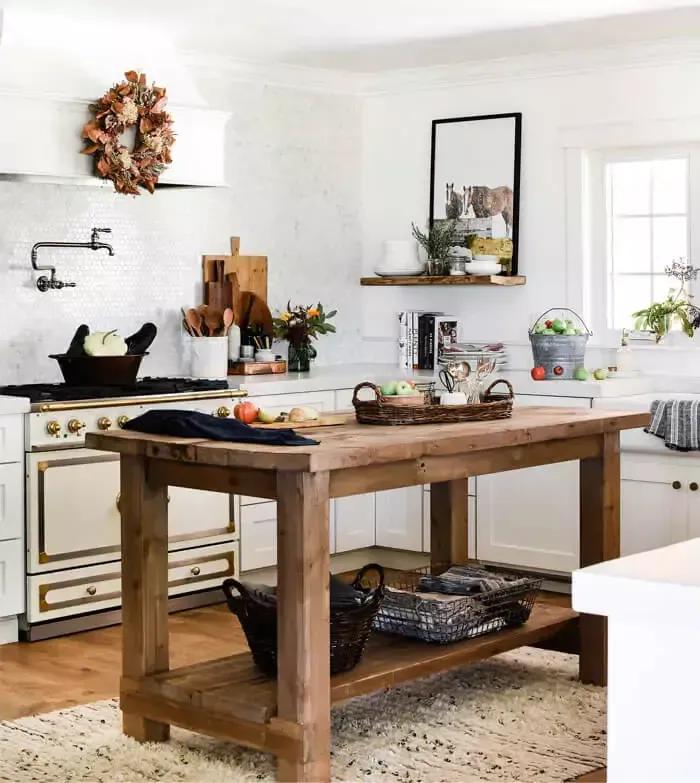
Boxwood Avenue @boxwoodavenue
If you have a kitchen island that is freestanding (not built-in), consider placing it in the center of a large area rug to provide cushion the whole way around as Chloe did here. Make sure that the width and length provide you enough space to comfortably stand completely on the rug when working at the island.
HALLWAY
Because there is little else in a hallway, a rug in the central focus. It adds style and defines the traffic flow through the narrow space.
- Runners are almost always the ideal choice for this area.
- The general rule of thumb is for runners to cover about 75% of the length of your hallway leaving at least 6” of exposed floor at both ends. There should also be space at both sides between the edge of the rug and the wall.
- For extremely long hallways, you may want to consider using multiple, matching rugs.
- If your hallways isn’t symmetrical, align the runner with the door.
- The legs of hallway furniture should not rest on the runner. Ideally, your furniture should rest on one side of the wall with the runner going down the center. This option is sometimes difficult in small homes, however.
ENTRYWAY
Using a rug in the entryway creates a welcoming space for guests when they first pass through your front door, giving them a glimpse of your home’s style. They are also serving a functional purpose of protecting your floors from tracked in dirt.
- Because everyone’s home is different, let the shape of your entryway dictate whether you choose a rectangular, round, octagonal, or runner shaped rug.
- For narrow entryways, use the width of your front door as a baseline for how wide the rug should be.
- Be sure to check the pile height of your rug to ensure your door will clear it when opened.
- If entryway isn’t symmetrical, alighn runner with door.
- There should be 6”-8” of floor space between your rug and entryway console or bench, if possible.
LAUNDRY ROOM
Laundry room rugs are there to provide comfort as you load and unload the washer and dryer, do handwashing, or iron. Depending on the layout of your space and where you’d most like something soft under your feet, you’d likely want to choose a runner down the middle leaving a border of flooring exposed on either side or a small rug in front of your sink.
HOME OFFICE
In a home office, rugs provide a bit of coziness and take the hard edge off of the sometimes heavy looking furniture.
- Most likely, you want your rug to lay in the center of your room leaving a border of exposed flooring around the entire space.
- Be sure that your chair is able to both be pushed in and pulled out from the desk without falling off of the rug based on the size you chose. This is especially important when your desk is pushed up against the wall because you don’t want the chair constantly catching where the rug ends as you move about.
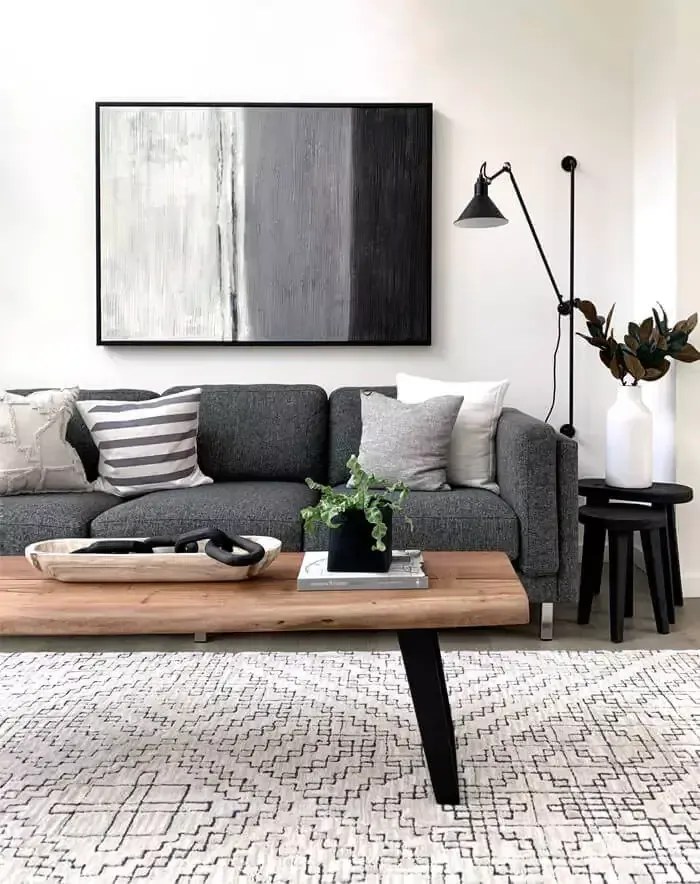
If you’d like some more visual references of the layouts being described in this post, click here to see over 100 examples featuring all different ways to arrange rugs throughout your home.
Hopefully this post will help you get your area rug purchase right the first time around, giving your home the look of being expertly designed. It is well worth planning and researching when buying something new. Be sure to save this post so that you can refer back to it whenever you are looking to update your rug!
READ NEXT: Outdoor Rug Guide

